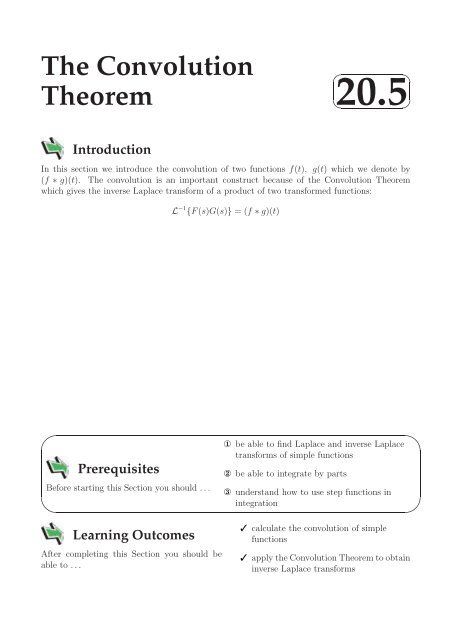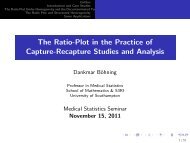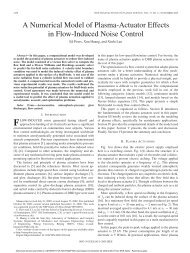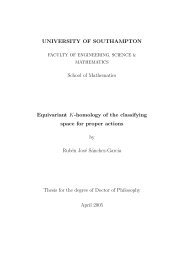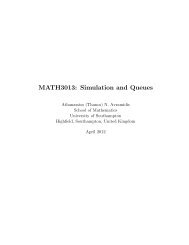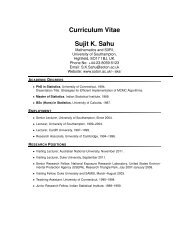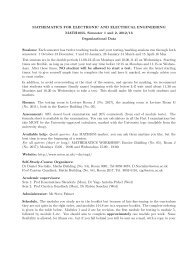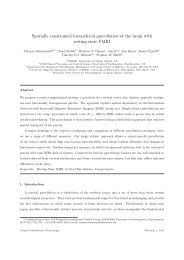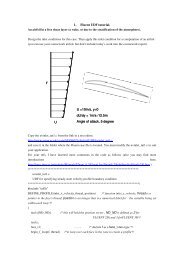2. The Convolution Theorem
2. The Convolution Theorem
2. The Convolution Theorem
You also want an ePaper? Increase the reach of your titles
YUMPU automatically turns print PDFs into web optimized ePapers that Google loves.
<strong>The</strong> <strong>Convolution</strong><br />
<strong>The</strong>orem<br />
Introduction<br />
✓<br />
✏<br />
20.5<br />
✒<br />
✑<br />
In this section we introduce the convolution of two functions f(t), g(t) which we denote by<br />
(f ∗ g)(t). <strong>The</strong> convolution is an important construct because of the <strong>Convolution</strong> <strong>The</strong>orem<br />
which gives the inverse Laplace transform of a product of two transformed functions:<br />
✬<br />
✫<br />
Prerequisites<br />
Before starting this Section you should ...<br />
Learning Outcomes<br />
After completing this Section you should be<br />
able to ...<br />
L −1 {F (s)G(s)} =(f ∗ g)(t)<br />
① be able to find Laplace and inverse Laplace<br />
transforms of simple functions<br />
② be able to integrate by parts<br />
③ understand how to use step functions in<br />
integration<br />
✓ calculate the convolution of simple<br />
functions<br />
✓ apply the <strong>Convolution</strong> <strong>The</strong>orem to obtain<br />
inverse Laplace transforms<br />
✩<br />
✪
1. <strong>The</strong> <strong>Convolution</strong><br />
Let f(t) and g(t) betwo functions of t. <strong>The</strong> convolution of f(t) and g(t) isalso a function of t,<br />
denoted by (f ∗ g)(t) and is defined by the relation<br />
−∞<br />
(f ∗ g)(t) =<br />
� ∞<br />
−∞<br />
f(t − x)g(x)dx<br />
However if f and g are both causal functions then (strictly) f(t),g(t) are written f(t)u(t) and<br />
g(t)u(t) respectively, so that<br />
� ∞<br />
� t<br />
(f ∗ g)(t) = f(t − x)u(t − x)g(x)u(x)dx = f(t − x)g(x)dx<br />
because of the properties of the step functions (u(t − x) =0ifx>tand u(x) =0ifx
Example Find the convolution of f(t) =tu(t) and g(t) =sin t.u(t).<br />
Solution<br />
Here f(t − x) =(t− x)u(t − x) and g(x) =sin x.u(x) and so<br />
� t<br />
(f ∗ g)(t) = (t − x) sin xdx<br />
0<br />
We will need to integrate by parts. We find, remembering again that t is a constant in the<br />
integration process,<br />
� t<br />
�<br />
�t � t<br />
(t − x) sin xdx = −(t − x) cos x − (−1)(− cos x)dx<br />
0<br />
� t<br />
0 0<br />
= [0+t] − cos xdx<br />
�<br />
0<br />
�t = t − sin x = t − sin t<br />
so that<br />
(f ∗ g)(t) =t − sin t or, equivalently, in this case (t ∗ sin t)(t) =t − sin t<br />
In the last example we found the convolution of f(t) = tu(t) and g(t) =<br />
sin t.u(t). In this exercise you are asked to find the convolution (g ∗ f)(t) that<br />
is, to reverse the order of f and g.<br />
Your solution<br />
Begin by writing (g ∗ f)(t) asanappropriate integral<br />
You should find, according to the definition g(t − x) =sin(t − x).u(t − x) and f(x) =xu(x)<br />
and so<br />
� t<br />
(g ∗ f)(t) = sin(t − x).xdx<br />
3 HELM (VERSION 1: March 18, 2004): Workbook Level 1<br />
20.5: <strong>The</strong> <strong>Convolution</strong> <strong>The</strong>orem<br />
0<br />
0
Your solution<br />
Now evaluate the convolution integral<br />
= t − sin t<br />
cos(t − x)dx<br />
� t<br />
This exercise illustrates the general result<br />
= [t−0] + [sin(t − x)] t<br />
0<br />
0<br />
0<br />
� t<br />
sin(t − x).xdx<br />
0<br />
� �t x cos(t − x) −<br />
Key Point<br />
(f ∗ g)(t) =(g ∗ f)(t)<br />
=<br />
(g ∗ f)(t) =<br />
You should find (g ∗ f)(t) =t − sin x since<br />
in words: the convolution of f(t) with g(t) isthe same as the convolution of g(t) with f(t).<br />
Obtain the Laplace transforms of f(t) =tu(t) and g(t) =sin t.u(t) and of<br />
(f ∗ g)(t). What do you notice?<br />
Your solution<br />
Begin by finding L{f(t)} and L{g(t)}<br />
from tables<br />
HELM (VERSION 1: March 18, 2004): Workbook Level 1<br />
20.5: <strong>The</strong> <strong>Convolution</strong> <strong>The</strong>orem<br />
L{f(t)} = 1<br />
s2 L{g(t)} = 1<br />
s2 +1<br />
4
Your solution<br />
Now find L{(f ∗ g)(t)}<br />
Your solution<br />
What do you observe?<br />
L{(f ∗ g)(t)} = L{t − sin t} = 1 1<br />
−<br />
s2 s2 +1<br />
From the example above (f ∗ g)(t) =t − sin t and so<br />
We see that the Laplace transform of the convolution of f(t) and g(t) isthe product of their<br />
separate Laplace transforms. This, in fact, is a general result which is expressed in the statement<br />
of the convolution theorem which we discuss in the next section<br />
= L{f(t)}L{g(t)} = F (s)G(s)<br />
<strong>2.</strong> <strong>The</strong> <strong>Convolution</strong> <strong>The</strong>orem<br />
�<br />
�<br />
1<br />
s2 +1<br />
1<br />
=<br />
s2 L{(f ∗ g)(t)} = 1 1<br />
−<br />
s2 s2 +1<br />
Let f(t) and g(t) becausal functions with Laplace transforms F (s) and G(s) respectively, i.e.<br />
L{f(t)} = F (s) adn L{g(t)} = G(s). <strong>The</strong>n it can be shown that<br />
Key Point<br />
L −1 {F (s)G(s)} =(f ∗ g)(t) or equivalently L{(f ∗ g)(t)} = F (s)G(s)<br />
Example Use the <strong>Convolution</strong> <strong>The</strong>orem to find the inverse transform of<br />
6<br />
s(s 2 +9) .<br />
5 HELM (VERSION 1: March 18, 2004): Workbook Level 1<br />
20.5: <strong>The</strong> <strong>Convolution</strong> <strong>The</strong>orem
Solution<br />
In this case we can, of course, find the inverse transform by using partial fractions and then<br />
using the table of transforms. That is:<br />
and so<br />
6<br />
s(s 2 +9)<br />
L −1<br />
�<br />
6<br />
s(s2 �<br />
+9)<br />
= (2/3)<br />
s<br />
= 2<br />
3 L−1<br />
− (2/3)s<br />
s 2 +9<br />
� �<br />
1<br />
−<br />
s<br />
2<br />
3L−1 �<br />
s<br />
s2 �<br />
+9<br />
= 2 2 u(t) − cos 3t.u(t)<br />
3 3<br />
However, we can alternatively use the <strong>Convolution</strong> <strong>The</strong>orem. Let us choose<br />
then<br />
So<br />
F (s) = 2<br />
s<br />
and G(s) = 3<br />
s 2 +9<br />
f(t) =L −1 {F (s)} =2u(t) and g(t) =L −1 {G(s)} = sin 3t.u(t)<br />
L −1 {F (s)G(s)} = (f∗g)(t) � t<br />
by the <strong>Convolution</strong> <strong>The</strong>orem<br />
= 2u(t − x) sin 3x.u(x)dx<br />
0<br />
Now the variable t can take any value from −∞ to +∞. Ift
Use the <strong>Convolution</strong> <strong>The</strong>orem to find the inverse transform of<br />
s<br />
H(s) =<br />
(s − 1)(s2 +1) .<br />
Your solution<br />
Begin by choosing two functions of s: that is, F (s) and G(s)<br />
f(t) =L −1 {F (s)} =e t u(t) and g(t) =L −1 {G(s)} = cos t.u(t)<br />
since, by inspection, we can write down their inverse Laplace transforms:<br />
and G(s) = s<br />
s2 +1<br />
Your solution<br />
Now construct the convolution integral<br />
F (s) = 1<br />
s − 1<br />
Although there are many possibilities it would seem sensible to choose<br />
e t−x u(t − x) cos x.u(x)dx<br />
0<br />
� t<br />
= L −1 {F (s)G(s)}<br />
� t<br />
= f(t − x)g(x)dx =<br />
0<br />
h(t) = L −1 {H(s)}<br />
You should obtain<br />
7 HELM (VERSION 1: March 18, 2004): Workbook Level 1<br />
20.5: <strong>The</strong> <strong>Convolution</strong> <strong>The</strong>orem
Your solution<br />
Now complete the evaluation of the integral. (Treat the cases t


